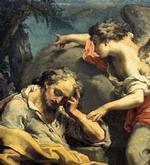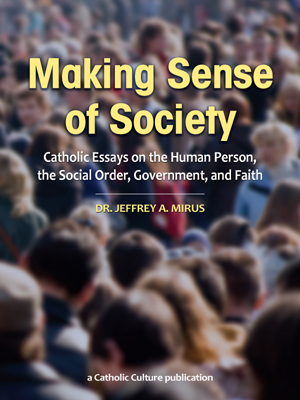The Father William Most Collection
Our Lady's Cooperation in the Redemption
[Published electronically for use in classes taught by Fr. Most and for private theological study.]
It is strange that one of the oldest teachings of the Church is unknown to most Catholics, namely, this cooperation.
We should define terms:1) objective redemption is the work of earning a title to all forgiveness and grace, by the great sacrifice. 2) Subjective redemption, the process of giving out the fruits of the objective redemption, throughout all ages.
Within the objective redemption, there can be remote cooperation, in faith accepting to be the Mother of the Redeemer, to furnish the flesh in which He could die; and immediate cooperation , which means some kind of role in the great sacrifice itself. We said "some kind" to indicate there is an added question: What kind of cooperation? By about 1959 theologians had finally agreed-- many had fought hard against it-that she did cooperate immediately in the objective redemption, in some way. But in what way? There were basically two proposals: a)active receptivity, proposed by German Mariologists. They said imagine someone putting out their hand, which is active, and then receiving something she had no share in producing: that would be mere receptivity. They reasoned that she is a type of the Church. But the Church contributes nothing to the objective redemption. So neither could she. Comment: There is no proof that she must not be able to do more than the Church. Really, the proposal is much like the Lutheran theology of redemption, in which humans merely "appropriate" what Christ won. b) a share in generating the title to all forgiveness and grace. Since the redemption is a new covenant, in which the critical condition is obedience, the obedience of Christ, we ask: Did she share in His obedience?
The early Fathers, beginning with St. Justin the Martyr (c. 145-50) taught that she was the New Eve, that just as the first Eve really contributed to the damage of original sin, so Our Lady really contributed to removing that damage. (We observe: Eve did not merely actively receive a sin; she shared in producing it). Most of the major Fathers have this theme, especially St. Irenaeus, who wrote (3. 11. 4): "Just as she [Eve]... being disobedient, became a cause of death for herself and the whole human race, so Mary... being obedient became a cause of salvation for herself and the whole human race". He also compared all sin, original and personal, to a complex knot. To untie it we would have to take the end of the rope backwards through every twist and turn to untie it. He then added: "Thus then, the knot of the disobedience of Eve was untied through the obedience of Mary;" Vatican II, On the Church §56 quoted both of these texts, with approval.
The Fathers however had in mind only remote cooperation, they spoke in the context of the Annunciation. This is true of St. Irenaeus too - yet the knot comparison implies more: it was not untied until the completion of the great sacrifice. So he implied more than he probably saw. But he was an instrument in the hands of Providence, and so that would be possible. Vatican II, ibid. §55, implied the same kind of instrumentality in saying that Genesis 3:15 and Isaiah 7:14 "in the light of later and full revelation, gradually bring before us the figure of the woman, the Mother of the Redeemer." So the inspired writers of Genesis and Isaiah may not have seen all that the Church now sees in these texts. But the Holy Spirit, the chief author did see and intend what the Church now sees. So we have anther case where someone in the hands of the Holy Spirit may write more than what he understood.
Vatican II, ibid. §58 wrote:" She bore with her union with her Son faithfully even to the Cross, where by design of divine Providence, she stood, grieved vehemently with her Only Begotten, and joined herself to His sacrifice with a Motherly love, lovingly consenting to the immolation of the Victim born of her." And in §61:"In suffering with Him as He died on the Cross she cooperated in the work of the Savior [redemption] in an altogether singular way, by obedience, faith, hope, and burning love, to restore supernatural life to souls."
So, Vatican II clearly taught 1) she did cooperate in the redemption, even on Calvary, 2) she did so as the New Eve (§56), or. by design of Providence; 3) she shared by way of obedience - mentioned twice in §56 and then in § 61.
So we conclude, Vatican II taught more than it realized -like the authors of Genesis, Isaiah, and St. Irenaeus. For it taught her cooperation was by way of obedience - which was the covenant condition, that which gave all the value to His sacrifice. If it had not been done in obedience it would have been a tragedy, not a redemption.
Actually, all Popes from Leo XIII up to Vatican II, and John Paul II after it, taught she did cooperate immediately in the objective redemption. Something repeated on the ordinary Magisterium level is infallible. Therefore... .
Further, John Paul II, in Redemptoris Mater, said on Calvary she joined with Him in the greatest self-emptying in history. For she not merely consented to His death, she was called on to positively will it, for it was the will of the Father that He die, die then, die horribly. All spiritual perfection requires that the soul will what He wills. And she had to do this in spite of her love for Him which was, as Pius IX said in Ineffabilis Deus, so great that "none greater under God can be thought of, and only God can comprehend it." (Pius IX spoke of holiness, but holiness and love are interchangeable). So her suffering was literally beyond the comprehension of anyone but God Himself!






